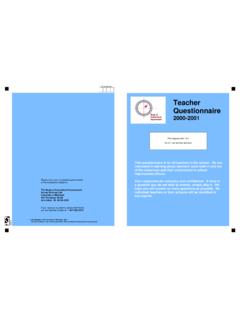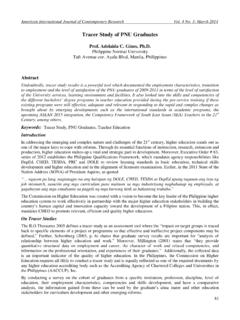Transcription of The South African Child Support Grant Impact Assessment
1 The South African Child Support Grant Impact AssessmentEvidence from a survey of children, adolescents and their householdsThe South African Child Support Grant Impact Assessment : Evidence from a survey of children, adolescents and their householdsMay 2012 This study was commissioned and funded by the Department of Social Development (DSD), the South African Social Security Agency (SASSA) and the United Nations Children s Fund (UNICEF) South Africa. The study was carried out by the Economic Policy Research Institute (EPRI) in partnership with the International Food Policy Research Institute (IFPRI), as part of a larger project partnership including the Institute for Development Studies (IDS), Oxford Policy Management (OPM), Reform Development Consulting (RDC) and Take Note Trading (TNT).
2 This research project is part of a multi-year integrated qualitative and quantitative Impact Assessment commissioned by the Department of Social Development, the South African Social Security Agency and UNICEF South study Team: Dr. Carolyn Heinrich (Economic Policy Research Institute (EPRI) and University of Texas at Austin), Dr. John Hoddinott (International Food Policy Research Institute), Dr. Michael Samson (EPRI), Mr. Kenneth Mac Quene (EPRI), Ms. Ingrid van Niekerk (EPRI), Mr. Bryant Renaud (EPRI). Gratitude to the adult and Child respondents for their inputs and contributions.
3 The valuable contribution of the following is also acknowledged: Selwyn Jehoma, Thilde Stevens, Maureen Motepe, Thabani Buthelezi and Dibolelo Ababio from the Department of Social Development; Eric Musekene, Alice Odhiambo and Rudzani Takalani, from SASSA; George Laryea-Adjei from UNICEF; Nkechi Obisie-Nmehielle (IOM); Dugan Fraser (Action Plus); Benjamin Davis (FAO); Ashu Handa (University of North Carolina); Jan Vorster (University of Stellenbosch); Linda Richter, Vuyiswa Mathambo and Lucia Knight (HSRC); Patrick Chiroro (IRI). Department of Social Development/ South African Social Security Agency/UNICEFAll care has been taken to ensure that the information is correct and original sources have been indicated for reference and verification.
4 With an identification of the Department of Social Development, South African Social Security Agency and UNICEF as source, the document may be freely quoted, reviewed, abstracted, reproduced and translated, in part or in whole, but not for sale nor for use in conjunction with commercial purposes. Original sources should be acknowledged where indicated in the citation: DSD, SASSA and UNICEF. 2012. The South African Child Support Grant Impact Assessment : Evidence from a survey of children, adolescents and their households. Pretoria: UNICEF South AfricaObtainable free of charge from:UNICEF, DSD and SASSAW ebsite: ; and are also referred to the complementary research report called Child Support Grant Evaluation 2010: Qualitative Research Report (Stephen Devereux [IDS], Michelle Adato [IFPRI], Rachel Sabates-Wheeler [IDS], Jesse McConnell [RDC], Elisabeth Becker [IFPRI]) dated June 2011, which presents the qualitative component of the evaluation.
5 Cover photograph: UNICEF/PirozziLayout: Handmade Communications South African Child Support Grant Impact AssessmentEvidence from a survey of children, adolescents and their householdsiiThe South African Child Support Grant Impact AssessmentOVERVIEW AND RESEARCH QUESTIONS The Child Support Grant (CSG) is an important instrument of social protection in South Africa, reaching over 10 million South African children each month. This report presents the findings of a research team s analysis of a specially designed survey fielded in rural and urban areas of five South African provinces, supporting the rigorous Impact Assessment of how access to the CSG affects key aspects of Child and adolescent well-being.
6 The South African Child Support Grant (CSG) was first introduced in 1998. Over the past 14 years, South Africa s social Grant programme has evolved into one of the most comprehensive social protection systems in the developing world. Expansions to the Child Support Grant s criteria for eligibility over this same period include an increase in the age limit from seven to eighteen years old, and adjustments to the income threshold to take inflation into account and improve equity. RESEARCH DESIGN, QUESTIONNAIRES AND DATAT hree questionnaires were designed to gather informa-tion on children, adolescents and their households.
7 Households with participating adolescents were given the CSG Adolescent Questionnaire and the CSG Household Questionnaire, while homes with participating young chil-dren were given the CSG Young Child Questionnaire and the CSG Household Questionnaire. In addition, adolescents completed a confidential, self-administered survey about their receipt of the CSG, school and work participation, and their engagement in risky behaviours. The sampling process took place in two stages. First, a random sample of locations, defined as the catchment areas for specific pay-points, was drawn from SASSA s administrative database.
8 These locations were sampled from each of five provinces: Eastern Cape, Gauteng, KwaZulu-Natal, Limpopo and Western Cape. Second, children were randomly selected from the identified paypoints in order to identify a group of 10-year-olds who enrolled in the CSG programme shortly after birth, compared to a group enrolled later at age four or older. Adolescents were selected around the age cut-off for eligibility in 2010, including those receiving and not receiving the CSG. The research team compared the results of the survey to other national household surveys, including the 2008 National Income Dynamics Survey (NIDS) and the 2010 General Household Survey (GHS)
9 , and found the sample largely representative of the corresponding national EVALUATION METHODOLOGY The methodology of this evaluation aims to measure causal programme impacts as the difference between observed out-comes for the beneficiaries and what would have been the outcomes if this group had not received the Child Support Grant or received it later versus earlier. The evaluation strategy controls for factors that might lead to an erroneous attribution of causality, including individual and household traits such as poverty status, exposure to shocks, demographic characteristics and other variables.
10 The evaluation employs non-experimental approaches rather than a randomised experiment because there is no practical or legal scope for randomly allocating grants in South Africa, and the single cross-sectional survey together with the sample variability in terms of timing and receipt of grants appropriately sup-ports and strengthens the evaluation approaches adopted for this study . The main method adopted for this study matches and compares households receiving the treatment (such as the Child Support Grant from shortly after the Child s birth) with a comparison group of households with similar observable characteristics that influence their probability of application for or receipt of the Child Support Grant .















